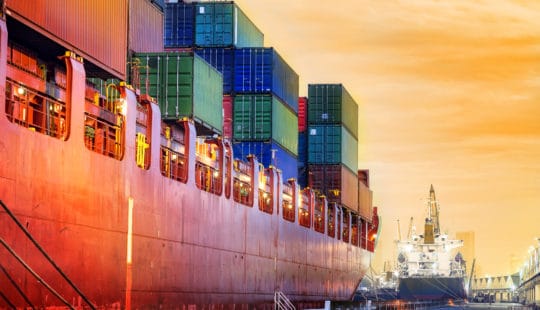As a boating enthusiast and scuba diver, I find peace whenever I return to the solitude of the sea. Whatever concerns occupy my mind while on land seem to dissipate into the endlessness of its calming waves. Yet experienced sailors and swimmers understand that, for all its allure, water holds just as much potential for turbulence as it does for tranquility.
Consider the recent discovery by scientists of Sir Ernest Shackleton’s Endurance, which sank off the Antarctic coast in 1915. Fortunately for the explorer and his crew of 27, all managed to survive. As for the shipwreck, scientists found it remarkably intact amid the frigid depths of Earth’s southernmost seas. But the photographs capture one significant change with the passage of time: the sunken vessel, like the craggy ocean floor surrounding it, now teems with life. At a depth exceeding 3,000 meters, triple the distance sunlight can travel underwater, how do ecosystems manage to thrive? And what can businesses, sometimes facing inhospitable conditions of their own above sea level, learn from the enterprising plants and animals whose habitat eludes visibility?
To run at their best, businesses carry out multiple operational processes simultaneously, maximizing efficiency and minimizing risk across them all. So too the complex networks of flora and fauna undersea. A lack of visibility presents challenges not only for aquatic ecosystems but for commercial ones as well, in the latter instance imperiling critical functions such as procurement and supply chain, logistics, and the maintenance of equipment connected by the Internet of Things (IoT). Business leaders increasingly look to the cloud for digital solutions to enhance visibility across all these functions. But they’re equally wise to gaze seaward as well for insights on instilling resilience. Disruption, after all, can leave wreckage at the bottom of an income statement just as it can at the bottom of an ocean.
At a time when viral variants, recurrent lockdowns, and geopolitical tensions continue to roil supply chains and labor markets, businesses require 360-degree visibility across the interconnected operations of trading partners and solution providers to maintain continuity, foster collaboration, and keep promises made to customers. Yet many procurement and supply chain professionals possess only fragmentary information about isolated business processes, unable to gain a comprehensive view across the four walls of their organization, let alone those of their buyers and suppliers. Integrated digital platforms, however, lend businesses the expansive view and data-driven insights they need to anticipate rapid shifts in supply and demand and suggest available alternatives for the sourcing of raw materials and indirect goods.
Yet while cloud-based business networks are a contemporary innovation to extend visibility where it runs scarce, they are hardly without precedent. Deep-sea creatures have evolved their own ingenious techniques for sharpening their acuity to procure food. Consider the Pacific barreleye, whose translucent head enables the fish to camouflage in total darkness while stalking its next meal. Or the stout blacksmelt, whose oversized eyes stand out from its otherwise modest frame. Or the scallop, whose 200 eyes peer behind mirror-like lenses, focusing in unison to magnify the tiniest trace of light undiscernible to animals further down the food chain.
Back above the surface, businesses lie vulnerable to disruption even when supply chain visibility remains intact. When finished goods pile up in logjammed seaports, for example, manufacturers can offer little solace to customers denied on-time shipments. To ensure prompt delivery via sea, road, rail, or air, businesses require unimpeded visibility across all facets of logistics. They rely on cloud-based networks to track shipments in real time, collaborate with transportation partners, and secure alternatives when unforeseen contingencies thwart the best laid plans.
Here too, lessons emerge from the deep. Spanning distances exceeding anything comparable on land, the ocean organizes logistics through vast networks known collectively as the biological pump. Life-sustaining elements, such as carbon, oxygen, nitrogen, and phosphorus, flow from the surface to the ocean floor and back again through intricate cycles of photosynthesis, decomposition, consumption, and sedimentation. The biological pump is also responsible for sending to the bottom of the sea much of the Earth’s excess carbon dioxide, which, if released, would oversaturate its atmosphere and overheat its surface. Through the resilient, never-ending exchange of resources essential to life both within and beyond its depths, the ocean maintains arguably the most elaborate logistical network ever devised.
Cloud-based business platforms operate on a planet-wide scale with unrivaled efficiency, too. Not only do they facilitate procurement, supply chains, and logistics between businesses and their trading partners, but in recent years they have begun to connect remote assets through the Internet of Things. This cloud-based capability, often called asset intelligence, has revolutionized the maintenance of equipment.
Suppose a utility operates a windmill farm offshore. All of the units require physical upkeep but accessing them can prove costly and dangerous. It can also prove futile if the windmill happens to be in perfect working order. But by linking together far-flung equipment virtually, businesses create digital twins – in lieu of natural eyesight – to inspect these assets from afar. Such cloud-based asset intelligence networks aid the operations not only of energy companies, but of rural health clinics, security firms, and even soft drink purveyors. Think of all the distributed vending machines requiring replenishment.
But how, devoid of light, do the creepiest, crawliest critters inhabiting the deep sea manage to ascertain their surroundings? How do they gather reliable, actionable intelligence on “asset” and threat, friend and foe, near and far? Consider the tripod fish, which elegantly stands atop narrow, leg-like fins, poised to sense distant vibrations from potential prey. The beaked whale, meanwhile, deploys echolocation, not unlike bats and submarines. By emitting short, high-frequency clicking sounds and waiting for them to bounce back, these mammals develop an acute awareness of their surroundings, often to the peril of less sensitive beasts who become breakfast. The vampire squid, meanwhile, oozes bioluminescent fluid to lure hungry, if unsuspecting, targets. For their part, sharks and stingrays detect electric currents to map their surroundings and navigate using the Earth’s magnetic field.
As the Endurance shipwreck-turned-aquarium makes vivid, the abyss of the icy sea imposes formidable obstacles to survival in an environment prone to volatility and unforgiving to the unadaptable. Yet nature has innovated surprisingly durable solutions for illuminating the fundamental biological processes that nourish sprawling ecosystems undersea. The cloud does much the same for networks of businesses engaged in commerce amid drier, if similarly disruptive, conditions. In fact, the cloud and the ocean are beginning to converge on an increasingly sustainable future for all the Earth’s inhabitants. The visibility made possible by cloud-based networks holds the potential to significantly reduce the volume of plastics cluttering the sea and encumbering the creatures great and small who call it home. As digital technologies give rise to sustainable solutions, resilient ecosystems thrive even in the darkest corners on Earth.
Andreas Heckmann is executive vice president, Product Engineering, and head of Customer Solution Support & Innovation at SAP.
Top image: Falklands Maritime Heritage Trust/National Geographic.
This article was originally published on the global SAP News Center.



